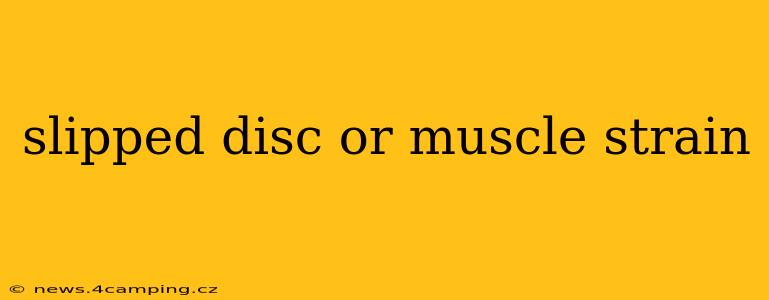Experiencing lower back pain? It's a common ailment, but pinpointing the cause—a slipped disc or a muscle strain—is crucial for effective treatment. This guide will help you understand the key differences between these two conditions, allowing you to better communicate with your doctor and navigate your recovery.
What is a Slipped Disc?
A "slipped disc," more accurately termed a herniated disc, occurs when the soft, gel-like center of an intervertebral disc pushes through a tear in the tougher outer layer. These discs act as cushions between the vertebrae in your spine. When a disc herniates, it can press on nearby nerves, causing pain, numbness, tingling, and weakness that often radiates down the leg (sciatica). The location of the herniation dictates the symptoms experienced.
Symptoms of a Slipped Disc
- Localized pain: Intense pain in the lower back, often worsened by movement.
- Radiating pain: Pain that shoots down one leg, often accompanied by numbness or tingling.
- Weakness: Muscle weakness in the leg or foot.
- Numbness: Loss of sensation in the leg or foot.
- Difficulty with bowel or bladder control: In severe cases.
What is a Muscle Strain?
A muscle strain, also known as a pulled muscle, involves an overstretching or tearing of muscle fibers in the lower back. This often occurs due to sudden movements, lifting heavy objects, or repetitive strain. Unlike a slipped disc, a muscle strain typically doesn't directly affect the nerves.
Symptoms of a Muscle Strain
- Localized pain: Pain concentrated in the lower back muscles.
- Muscle spasm: Tightness and cramping in the affected muscles.
- Stiffness: Difficulty bending or moving the lower back.
- Tenderness to the touch: Pain when the affected area is pressed.
- Swelling: In some cases.
How to Tell the Difference Between a Slipped Disc and a Muscle Strain?
Differentiating between a slipped disc and a muscle strain can be challenging, even for medical professionals. Many symptoms overlap. However, some key distinctions can help guide you:
- Radiating pain: Pain that travels down the leg is a strong indicator of a slipped disc. Muscle strains usually cause pain localized to the back.
- Neurological symptoms: Numbness, tingling, and weakness are more commonly associated with nerve compression from a slipped disc.
- Severity of pain: While both conditions can cause intense pain, the pain from a slipped disc is often more severe and debilitating.
How are Slipped Discs and Muscle Strains Diagnosed?
A doctor will typically conduct a physical exam to assess your range of motion, reflexes, and neurological function. Imaging tests like X-rays, MRIs, or CT scans may be used to confirm the diagnosis, especially in the case of a suspected slipped disc.
Can a slipped disc cause a muscle strain?
Yes, a slipped disc can indirectly cause muscle strain. The pain and inflammation caused by a herniated disc can lead to muscle spasms and tightness as the body tries to protect the injured area. This can further exacerbate the pain and make it difficult to differentiate between the primary problem (slipped disc) and the secondary muscle strain.
What is the treatment for a slipped disc or muscle strain?
Treatment varies depending on the severity and diagnosis. Conservative methods such as rest, ice, heat, over-the-counter pain relievers, and physical therapy are often effective for both conditions. In severe cases of a herniated disc, surgery may be necessary.
When Should I See a Doctor?
Seek medical attention if:
- Your pain is severe and doesn't improve with home treatment.
- You experience numbness, tingling, or weakness in your legs or feet.
- You have difficulty with bowel or bladder control.
- Your pain worsens over time.
This information is for general knowledge and does not constitute medical advice. Always consult with a healthcare professional for diagnosis and treatment. They can accurately assess your condition and recommend the appropriate course of action.
